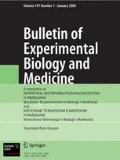Rats were exposed to fluoroplast-4 pyrolysis products (sample weight 2.6 g, pyrolysis temperature 440-750°C, pyrolysis duration 4 min) containing perfluoroisobutylene over 15 min. Lung tissue samples for histological and electron microscopic examination were isolated in 3 and 30 min after intoxication and processed routinely. Histological examination revealed no structural changes in the lungs. In ultrathin sections of rat lungs, some changes in the structure of type I pneumocytes were detected in 3 min after the exposure: detachment of cytoplasmic processes and the appearance of transcytosis pores. These changes attested to impaired cell—cell interactions and their adhesion to the basement membrane, where structural disorganization and edema of the collagen matrix were observed. In 30 min following exposure, the signs of damage to type I pneumocytes became more pronounced. The increase in the equivalents of transcellular and paracellular permeability in the alveolar lining profile was observed. No changes in the pulmonary capillary endotheliocytes were detected, which suggest that type I pneumocytes are the primary target of the toxic effect of perfluoroisobutylene. The vulnerability of a particular cell population, in view of specific metabolism of these cells, can be the key to deciphering of the mechanisms of the toxic effect of pyrolysis products of fluorinated polymer materials.
Similar content being viewed by others
References
Gritsan AN. Diagnosis and Intensive Therapy of Acute Respiratory Distress Syndrome. All-Russian Public Organization Federation of Anesthesiologists and Resuscitators. [URL: http://far.org.ru/recomendation].
Tolkach PG, Basharin VA, Chepur SV, Vladimirova OO, Alekseeva II, Solovyeva TS. Mechanisms of Pulmonary Toxicity of Perfluoro-n-Alkane Pyrolysis Products with Consideration of the Structural Features of the Blood-Air Barriers. Bull. Exp. Biol. Med. 2020;168(3):345-348. https://doi.org/10.1007/s10517-020-04705-z
Brown RF, Rice P. Electron microscopy of rat lung following a single acute exposure to perfluoroisobutylene (PFIB). A sequential study of the first 24 hours following exposure. Int. J. Exp. Pathol. 1991;72(4):437-450.
Meng G, Zhao J, Wang HM, Ding RG, Zhang XC, Huang CQ, Ruan JX. Injury of cell tight junctions and changes of actin level in acute lung injury caused by the perfluoroisobutylene exposure and the role of myosin light chain kinase. J. Occup. Health. 2011;53(4):250-257.
Meng G, Zhao J, Wang HM, Ding RG, Zhang XC, Huang CQ, Ruan JX. Cell injures of the blood-air barrier in acute lung injury caused by perfluoroisobutylene exposure. J. Occup. Health. 2010;52(1):48-57.
Tsai WT. Environmental hazards and health risk of common liquid perfluoro-n-alkanes
Zhang Y, Fan L, Xi R, Mao Z, Shi D, Ding D, Zhang Z, Wang X. Lethal concentration of perfluoroisobutylene induced acute lung injury in mice mediated via cytokins storm, oxidative stress and apoptosis. Inhal. Toxicol. 2017;29(6):255-265.
Zhao J, Shao Z, Zhang X, Ding R, Xu J, Ruan J, Zhang X, Wang H, Sun X, Huang C. Suppression of perfluoroisobuthylene induced acute lung injury by pretreatment with pyrrolidine dithiocarbamate. J. Occup. Health. 2007;49(2):95-103.
Author information
Authors and Affiliations
Corresponding author
Additional information
Translated from Byulleten’ Eksperimental’noi Biologii i Meditsiny, Vol. 169, No. 2, pp. 235-241, February, 2020
Rights and permissions
About this article
Cite this article
Tolkach, P.G., Basharin, V.A., Chepur, S.V. et al. Ultrastructural Changes in the Air—Blood Barrier of Rats in Acute Intoxication with Furoplast Pyrolysis Products. Bull Exp Biol Med 169, 270–275 (2020). https://doi.org/10.1007/s10517-020-04866-x
Received:
Published:
Issue Date:
DOI: https://doi.org/10.1007/s10517-020-04866-x


